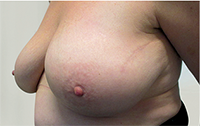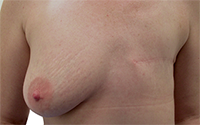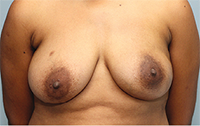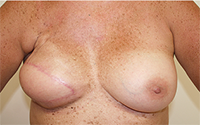- Home
- Breast cancer
- Treatment
- Surgery
- What your breast looks like after surgery
What your breast looks like after surgery
How your breast will look after surgery depends on the type of surgery that you have, as well as the size of your breast and your body shape. It can take up to a few weeks for any bruising and swelling of the surgery area to go away.
Learn more about:
Changes after surgery
| After breast-conserving surgery | The size and position of the scar will depend on how much tissue is removed. The scar will usually be less than 10 cm and near where the cancer was or along the areola. But this can vary depending on your breast size and how much cancer needs to be removed. It can also change if you need to have further surgery to remove more tissue. If a larger area needs to be removed, surgical techniques known as oncoplastic surgery can reshape the breast after breast-conserving surgery. |
| After a mastectomy | The scar will be across the skin of the chest. If you have surgery to the lymph nodes, the scar will also be in the armpit. At first the scar will be firm, slightly raised and red. Over the next few months, it will flatten and fade. |
| Impact on self-esteem | Scars or changes to how your breast looks can affect how you feel about yourself (self-image and self-esteem). It’s common to feel a sense of loss if you’ve had a mastectomy (or part of your breast removed), and you may find that your sense of femininity or sense of identity has been affected. |
| Seeking support | Talking to someone who has had breast cancer surgery can be helpful. Cancer Council’s Cancer Connect program may be able to link you to others who’ve had a similar experience. Speaking with a counsellor or psychologist for emotional support and coping strategies can also help. Call Cancer Council 13 11 20 for details. |
Breast appearance after surgery
What your breast looks like after surgery will vary from person to person, and depend on the type of breast surgery and how much tissue is removed.
The pictures below give some examples, however, ask your surgeon for more photographs to help you choose the surgery that’s right for you.
Breast-conserving surgery
 |
Two years after surgery to left breast. The scar can still be seen but has healed and faded a little. The size of the scar varies but can be around 10cms. The surgery was followed by radiation therapy. |
Mastectomy
 |
Left breast removed, with no reconstruction. All possible breast tissue has been removed and the scar runs horizontally across the chest wall. This photo is some time after surgery and shows results once the scar has healed. |
Nipple-sparing mastectomy with implant reconstruction
 |
Left breast removed with a nipple-sparing mastectomy, followed by reconstruction us an implant. If it is not possible to keep the nipple, there is the option of having a nipple |
Mastectomy with a flap reconstruction
 |
Right breast removed, followed by a breast reconstruction using tissue from the back. Tissue from the abdomen, buttock or thigh can also be used for a reconstruction. You can choose to have a nipple reconstruction later. |
→ READ MORE: Side effects of surgery for cancer breast
Podcast: Coping with a Cancer Diagnosis
Listen to more of our podcast for people affected by cancer
More resources
A/Prof Elisabeth Elder, Specialist Breast Surgeon, Westmead Breast Cancer Institute and The University of Sydney, NSW; Collette Butler, Clinical Nurse Consultant and McGrath Breast Care Nurse, Cancer Support Centre, Launceston, TAS; Tania Cercone, Consumer; Kate Cox, 13 11 20 Consultant, Cancer Council SA; Dr Marcus Dreosti, Radiation Oncologist and Medical Director, GenesisCare, SA; Dr Susan Fraser, Breast Physician, Cairns Hospital and Marlin Coast Surgery Cairns, QLD; Dr Hilda High, Genetic Oncologist, Sydney Cancer Genetics, NSW; Prof David W Kissane AC, Chair of Palliative Medicine Research, The University of Notre Dame Australia, and St Vincent’s Hospital Sydney, NSW; Prof Sherene Loi, Medical Oncologist, Peter MacCallum Cancer Centre, VIC; Dr W Kevin Patterson, Medical Oncologist, Adelaide Oncology and Haematology, SA; Angela Thomas, Consumer; Iwa Yeung, Physiotherapist, Princess Alexandra Hospital, QLD.
View the Cancer Council NSW editorial policy.
View all publications or call 13 11 20 for free printed copies.



